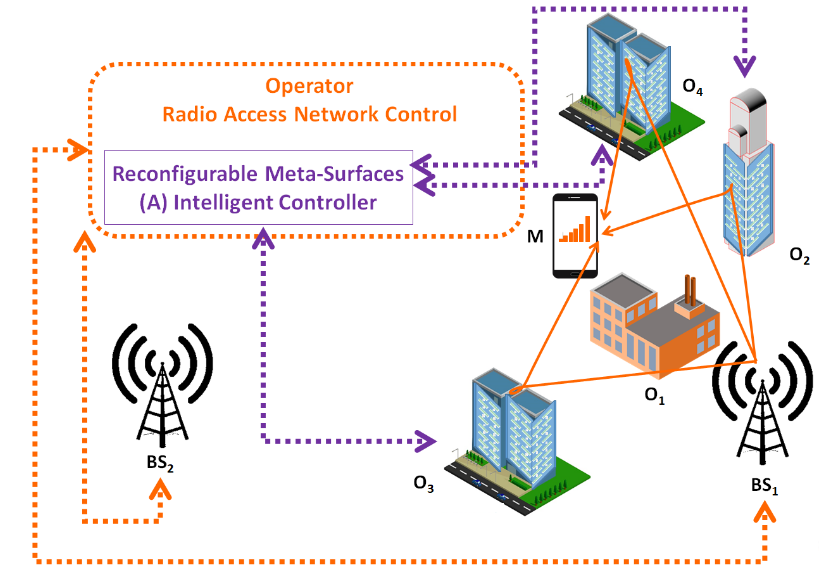Reconfigurable Intelligent Surfaces (RIS) goes by several names as an emerging technology. According to Marco Di Renzo, CNRS Research Director at CentraleSupélec of Paris-Saclay University, it is also known as Intelligent Reflecting Surfaces (IRS), Large Intelligent Surfaces (LIS), and Holographic MIMO. However it is referred to though, it’s a key factor in an ambitious collaborative project entitled AI-enabled Massive MIMO (AIMM), on which Di Renzo is about to start work.
Early Stages of RIS Research
Di Renzo refers to “RIS,” as does the recently established Emerging Technology Initiative of the Institute of Electrical and Electronics Engineers (IEEE). Furthermore, Samsung used that same acronym in its recent 6G Vision whitepaper, calling it a means “to provide a propagation path where no [line of sight] exists.” The description is arguably fitting considering there is no clear line of sight in the field, with a lot still to be discovered.
The intelligent surfaces, as the name suggests, possess reconfigurable reflection, refraction, and absorption properties with regard to electromagnetic waves. “We are doing a lot of fundamental research. The idea is really to push the limits and the main idea is to look at future networks,” Di Renzo said.
The project itself is two years in length, slated to conclude in September 2022. It’s also large in scale, featuring a dozen partners including InterDigital and BT, the former of which is steering the project. Arman Shojaeifard, Staff Engineer at InterDigital, serves as AIMM Project Lead. According to Shojaeifard, the “MIMO” in the name is just as much a nod to Holographic MIMO (or RIS) as it is to Massive MIMO.
“We are developing technologies for both in AIMM: Massive MIMO, which comprises sector antennas with many transmitters and receivers, and RIS, utilising reconfigurable reflect arrays for Holographic MIMO radios and smart wireless environments,” he explained.
Whereas reflective surfaces have generally been around for a while to passively improve coverage indoors, RIS is a recent development, with NTT Docomo demonstrating the first 28GHz 5G meta-structure reflect array in 2018. Compared to passive reflective surfaces, RIS also has many other potential use cases.

“Two main applications of metasurfaces as reconfigurable reflect arrays are considered in AIMM,” said Shojaeifard. “One is to create smart wireless environments by placing the reflective surface between the base station and terminals to help existing antenna system deployments. And two is to realise low-complexity and energy-efficient Holographic MIMO. This could be a terminal or even a base station.”
Optimising the Operation through Machine Learning
The primarily European project includes clusters of companies in Canada, the UK, Germany, and France. In France specifically there are three partners: Nokia Bell Labs; Montimage, a developer of tools to test and monitor networks; and Di Renzo’s CentraleSupélec, for which he serves as Principal Investigator. Whereas Nokia is contributing to the machine-learning-based air interface of the project, Di Renzo is working on the RIS component.
“From a technological point of view, the idea is that you have many antennas in Massive MIMO, but behind each of them there is a lot of complexity, such as baseband digital signal processing units, RF chains, and power amplifiers,” he said. “What we want to do with [RIS] is to try to get the same benefits or close to the same benefits as Massive MIMO, as much as we can, but […] get the complexity, power consumption, and cost as low as we can.”
The need for machine learning is two-pronged, according to Di Renzo. It helps resolve a current deficiency regarding the analytical complexity of accurately modeling the electromagnetic properties of the surfaces. It also helps to optimise the surfaces when they’re densely deployed in large-scale wireless networks through the use of algorithms.
“[RIS] can transform today’s wireless networks with only active nodes into a new hybrid network with active and passive components working together in an intelligent way to achieve sustainable capacity growth with low cost and power consumption,” he said.
Ready, AIMM…
According to Shojaeifard, the AIMM consortium is targeting efficiency dividends and service differentiation through AI in 5G and Beyond-5G Radio Access Networks. He said InterDigital’s work here is closely aligned with its partnerships with University of Southampton and Finland’s 6G Flagship research group.
Meanwhile, Di Renzo believes the findings to be made can provide the interconnectivity and reliability required for applications such as those in industrial environments. As for the use of RIS in telecoms networks, it’s a possibility at the very least.
“I can really tell you that this is the moment where we figure out whether [RIS] is going to be part of the use of the telecommunications standards or not,” he said. “During the summer, many initiatives were created within IEEE concerning [RIS] and a couple of years ago for machine learning applied to communications.”
“We will see what is going to happen in one year or a couple of years, which is the time horizon of this project…This project AIMM really comes at the right moment on the two issues that are really relevant, the technology which is [RIS] and the algorithmic component which is machine learning […] It’s the right moment to get started on this project.”
Feature image courtesy of Shutterstock.







